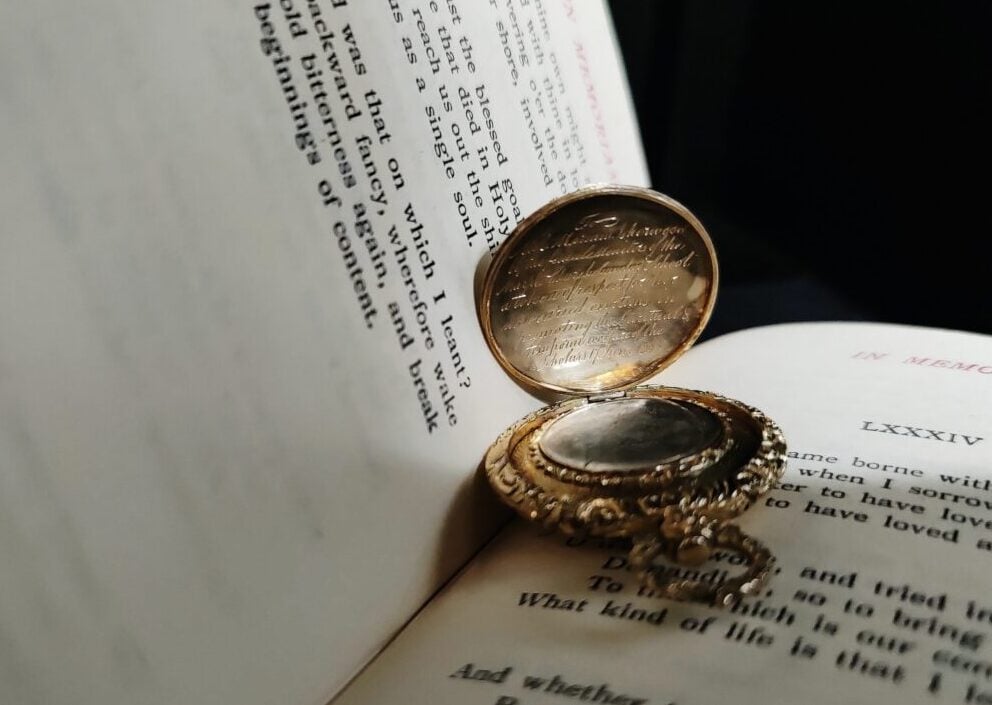
Antique jewellery is a window into the past lives of those who came before. This piece from the personal collection of the Kalmar's is a perfect encapsulation of how these jewels connect us to a different time, place and person. This item is a vinaigrette case and is layered in both sentiment and purpose. Through the existence of this item, we meet Miss Miriam Isherwood and her aristocratic family whose lives unfolded in the quaint town of Marple, Cheshire.
Upon first glance, you would be forgiven for mistaking this piece as an item of mourning jewellery, created to mark the bereavement of a loved one. The lock of woven hair and the inscription on the reverse side of the locket are common aesthetic elements of mourning jewels. However, upon further inspection it is evident that this item was gifted with another sentiment in mind for the recipient.
The inscription upon the inside lid gifts us insight into the intended sentiment of the piece. The cursive font is so decorative and neatly done that it is hard to believe that it was engraved by hand. Undoubtedly the work of a master engraver, the length and consistency of the message that has been inscribed upon the lid is truly remarkable. With careful inspection we can read the inscription as follows;
“To Mifs Miriam Isherwood,
By the female monitors of the,
Marple Church Sunday School,
A token of respect for her,
Unwearied exertions in,
Promoting the spirituals,
Temporal welfare of new,
Scholars 17 June 1839"
After deciphering the inscription, we begin to understand the circumstance surrounding this jewel and its intended recipient. The beneficiary of the piece was Miriam Isherwood as a token of respect for her work as a Monitor at the Marple Sunday School gifted to her by her colleagues.
Another element that adds to the sentiment of the piece is the inclusion of plaited hair in the locket compartment. During the Victorian era, of which this piece originates, “hair compartments are to be seen on every kind of jewel from this time" (Hinks, 1975). Hair was a common token to be gifted as a token of friendship and love.
“There's different kinds of hair art and there are different purposes; one is for mourning, and then one is for family trees, or friendship keepsakes, so there's different imagery you'll see in those things (Burgess, 2018).
When we consider the circumstances in which this piece was gifted, it is unlikely that the hair contained in the piece is that of Miriam Isherwood. This is a fair assumption as the piece is dated 1839 and records show that Miss Miriam Isherwood passed away in 1870. It is therefore, very unlikely that the gift givers would have had access to Miss Isherwood's own hair. We can speculate that the hair within the piece was that of the gift givers, the female monitors of Marple Church Sunday School, or perhaps even that of the students which Miriam Isherwood offered spiritual guidance. Although we cannot know for sure, a locket containing the hair of her peers or her students as a sentiment of thanks for her service is likely to fit the occasion for which the piece was gifted.
The style of hairwork featured in the piece was created using a palette work technique. “Palette work tends to be for jewellery and larger works, and is a technique where you'll see woven hair in patterns. Clean, flattened hair was woven or mixed with a sap-like material to create a sheet, which was then crafted into shapes that usually goes under glass, or it goes on top of ivory, in jewellery" (Burgess, 2018). Considering the technique, it is possible that the hair enclosed in this piece was that of multiple people that had been worked together in this way.
Jewellery in the Victorian era was renowned for being deeply sentimental but another important aspect of design was utilitarian function. This piece serves as an example of this with the reverse side of the locket being utilised as a vinaigrette. Vinaigrette cases were used to house a perfume-soaked sponge or piece of cotton that could be brought to the nose to mask unpleasant odours. “During the 19th century, vinaigrettes were a fashionable indication of social ranking, as those who were able to afford perfume or concern themselves with their outward appearance at all, were among the elite. Sanitisation standards were low for all including the highest classes, but they were able to compensate with perfume which would distinguish them from the working class" (AC Silver, 2022). Therefore, through this piece we can begin to understand the social ranking of the Isherwood family. A piece such as this would likely have been worn suspended from a chatelaine at Miss Isherwood's waist, a truly thoughtful and useful gift.
This piece not only provides us with Miss Isherwood's name but it connects us to the church in Marple, Cheshire where she received this gift some 183 years ago. Miriam Isherwood was the daughter of John Bradshaw-Isherwood and Elizabeth Bradshaw-Isherwood born in 1816. She was one of seven daughters and one brother who made up the Isherwood clan, a highly respectable family from the quaint town of Marple. The Bradshaw-Isherwood family were one of the most notable families within this region and the lavish Marple Hall has been the ancestral estate to the family for many generations. The Bradshaw-Isherwood family are widely documented for making substantial contributions to the Marple Church and community. As such, it comes as no surprise that a piece such as this, would be gifted to a member of the Isherwood family.

Further research reveals the impact which the aristocratic Isherwood-Bradshaw family have had on the region of Marple and to English history. When tracing the ownership of Marple Hall (pictured right) we see that the family of Miss Miriam Isherwood were descendants of Lord President John Bradshaw, whose father Henry Bradshaw II and older brother Henry Bradshaw III were both noted as Landlords of Marple Hall. John Bradshaw made a significant impact to the history of England with his close political connections to Oliver Cromwell and his appointment as the Lord President of the Council of State. His legacy would be one shrouded in controversy for his role in issuing the warrant for the execution of King Charles I in 1649. When the crown was restored to King Charles II, he condemned the actions of regicide and therefore John Bradshaw can be considered a divisive figure when reviewing English history. Centuries on from their ancestor's tribulations, the Bradshaw family lived in relative obscurity with no other notable endeavours into political life. They appeared by all counts to have lived a life of quiet privilege within the town of Marple and surrounds.
This item, a token of gratitude, connects us to the life of Ms. Miriam Isherwood and her distinguished family ties in Marple, Cheshire. With this tangible connection to the parish of the Marple Church community, we are able to greater understand the local history of this area and also the Bradshaw-Isherwood family. Unfortunately, Miss Isherwood's family home, Marple Hall, is no longer standing with only minor ruins remaining. The Marple Church is still in operation, as is the Sunday School of which Miss Isherwood pioneered.
Sources:
- AC Silver (2022). History of a vinaigrette, AC Silver UK; https://www.acsilver.co.uk/shop/pc/vinaigrette-history-what-is-a-vinaigrette-d138.htm,
- Ancestry (2022). John Bradshawe Isherwood 1776-1839'; https://www.ancestry.com.au/genealogy/records/john-bradshawe-isherwood-24-12fkkg2,
- Burgess, Anika (2018). The intricate craft of using human hair for jewelry, art and decoration, Atlas Obscura; https://www.atlasobscura.com/articles/intricate-craft-art-human-hair-jewelry-mourning-braid-mutter-museum
- Burke, John (1875). Burke's genealogical and heraldic history of the landed gentry; volume 1, H.Colburn, page 639; https://books.google.com.au/books?id=YdIKAAAAYAAJ&pg=PA639&lpg=PA639&dq=John+Bradshaw+1659+family+tree+to+john+isherwood&source=bl&ots=qGxqqX9d5J&sig=ACfU3U2Y_0Hwvig3MW2b0GvZu2DfOGy5wQ&hl=en&sa=X&ved=2ahUKEwit6fuH_dX2AhV-xzgGHTQMCWkQ6AF6BAgZEAM#v=onepage&q=John%20Bradshaw%201659%20family%20tree%20to%20john%20isherwood&f=false
- Dean & Chapter of Westminster Abbey (2022). John Bradshaw; politician and lawyer, Westminster Abbey; https://www.westminster-abbey.org/abbey-commemorations/commemorations/john-bradshaw
- Hinks, Peter (1975). Nineteenth century jewellery; Faber and Faber; London.
- The Marple Website (2020). Ownership of Marple Hall; https://www.marple.website/local-history/marple-hall.html






